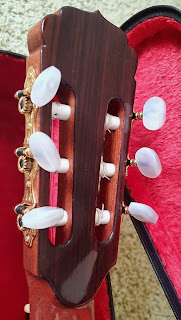The way the topnut has been mounted is visible here as well as the tuners of which the knobs are riveted.
The bridge form differs from the usual Spanish way of
making a bridge: A bit more square around the bridgebone
and a less wide string tie block not parallel to the sound-
board. I've added these pictures as coincidentally Hauser
guitars of that Era seems to be occupied with the same
bridge model. Good company anyway
Made out of ebony they are very sturdy but in order to have
a near perfect octave pitch I removed the contact area to the right
which in fact is not customary. Problem indeed can be a kind of
rattle coming from this way of constructing. Not present here,
Also the two inlays seems to be identical to the Hermann Hauser
models of that time. Beware and take a look at the first name
as Hermann Hauser is a totally different guitar compared to the
somewhat less interesting Karl Hauser guitars.
Oscar Teller 8/A
The first step in restoration of this Oscar Teller 8/A model was
to remove the lacquer over the whole instrument. As the lacquer
showed some craquele and had a lot of dirty and unprotected
bare wood spots that was a necessary move.
The back that already has been cleaned and is showing the
bare wood. It explains the prefix "A" in the model number:
The "A" stands for Ahorn, the German name for Maple.
Maybe a bit more uncommon but maple has some qualities
of its' own. And let us not forget: Antonio de Torres as
well as Vicente Arias, two venerable luthiers of the 19th
century also made concert guitars with maple sides and
back. To these days it still is a choice of luthiers but
the classical players, being quite conservative, are not
that eager to embrace the use of maple as it doesn't reply
to real tradition in wood use for concert guitars.
Biggest problem here was the purling and the soundboard
itself that was already loose at this spot. The purfling simply
was gone already. Luckily I found an old rosette of another
German built guitar that I've kept in storage.
And after several hours of work this is the result. It has
been composed with a lot of very thin layers and therefore
the only solution is to use some fine veneer blades and
make layers out of that. Do not glue them together but
only at the bottom where they are resting.
As the label attests this guitar is coming out of the same year
(and collection) as the model 8/P presented here above.
These two guitars are coming out of a bigger collection
most likely used for educational purposes. But the teachers
should have been more aware of the quality the guitars
provided here. They were not very prudent so to say....
A close shot where you can determine all those layers.
But the back will be brought back in a like new condition.
As the head had suffered some serious injuries there
was a need to restore the back. I used the same procedure
Wolfgang Teller uses for his present 8/P model by using
the same wood as the soundbox to kind of veneer the
back of the head. I could have used ebony but seeing
the picture here below I'm glad I didn't. I used maple.
On a rosewood guitar Mr. Teller uses rosewood for
the back of the head as can be seen here.
Now there is so much harmony when observing
this guitar from the back though still unfinished on
the left but lacquered on the right. The beautiful
figured maple is there to its' full potentials.
Louis Theress Guitar
Recently I obtained this guitar at an auction in England
I was captured by its' sound and the high degree of work-
manship. Already in playable and restored condition.
Maybe the "LaCote" shaped headform triggered me.
Opposed to many 19th century guitars the sides and
back haven't been veneered on the inside so solid
pieces of rosewood are used here along with a fine
grained table. The neck has been veneered with
an ebony layer while inlay work is meticulous.
Bindings, also on the back, are executed in ivory.
Special attention for these well working tuners as these
can also be found on some Antonio de Torres guitars.
The shape of the knobs on the tuner can be found later
on the Robert Bouchet guitars and ironically keep
popping up, also from Chinese manufacturers.
It is no surprise that the builder although French had his
shop in London and was a successor of Jerome Gerard.
Theress also had a shop in Paris so French after all.
Most likely still the original bridge.

The LaCote style head and slot execution.
Also the neck to head joint betrays skilled
workmanship as this ornament has been
veneered with a layer of ebony afterwards.
The execution of the heel is pointing towards the London
dealer / luthier Louis Theress, a pupil of Gerard who had
a workshop both in London and Paris.
The lining can be studied by clicking on this picture.
And here beyond of course.












































Geen opmerkingen:
Een reactie posten